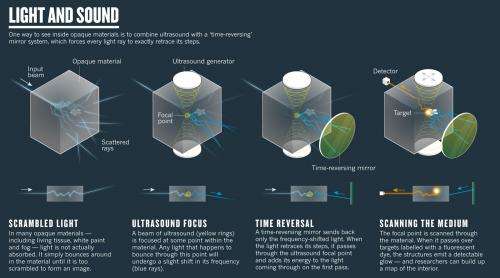February 16, 2015 weblog
Scientists making progress with techniques that allow for seeing through opaque materials

(Phys.org)—It has been a desire, if not a dream for many throughout human history, to create a device that allows for seeing through walls (ala Superman), inside the human body or through a shield so that the enemy can be seen without risk. Surprisingly, over the past several years, scientists have begun to find ways to do such things—this week author/journalist Zeeya Merali offers a News Feature in the journal Nature outlining research in this area and where she feels it might be heading.
As Meralis notes, it was just eight years ago that a pair of researchers (Allard Mosk and Ivo Vellekoop) working at the University of Twente in Enschede, the Netherlands found a way to shine a light through an opaque material, igniting a rush by others to investigate their discovery further. Their work, and the work done by others after them is all based on unscrambling light that has been scattered after running through a material.
In the original experiment, the researchers borrowed algorithms used by astronomers to resolve scattered light—called adaptive optics, it is a way to use a computer to make sense of the scattering that occurs and un-scatter it, allowing for a clear view of stars and other objects out in space. In the lab, the researchers covered a plate of glass with paint and then ran a beam of light through a spatial light modulator before it struck the target and passed through it—allowing them to measure a pinpoint of light on the other side.
Subsequent research has focused mainly on trying to see through/inside living tissue, to allow doctors to see tumors, etc. without having to perform exploratory surgery. X-rays and MRI's are good, but seeing inside the body directly with light would be much better. One promising approach has been to modify the technique by simultaneously focusing ultrasonic waves on the target—it helps the computer descramble the light by shifting its frequency—and then bouncing the rays back with a mirror, adding to the initial energy. Also, more recently, another team found a way to dramatically speed up the process, (Mosk and Vellekoop's experiment took over an hour) reducing the problems caused by living tissue that moves—they got it down to just 5.6 milliseconds.
Nobody really knows at this point whether the research will ultimately reveal a way to look all the way into a human patient (thus far a mouse's ear is as far as they have gotten), or through walls or other objects, but Merali appears confident that we will get closer, and while that would definitely benefit medical applications, how it might be used in other applications, remains to be seen.
More information: Optics: Super vision, Nature, www.nature.com/news/optics-super-vision-1.16877
Journal information: Nature
© 2015 Phys.org



















